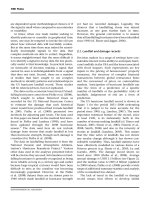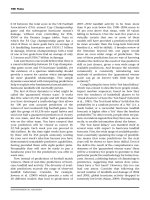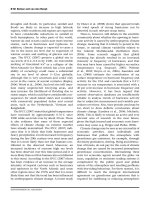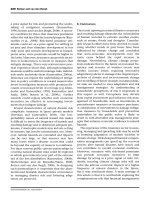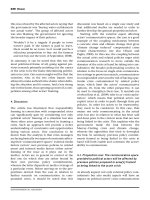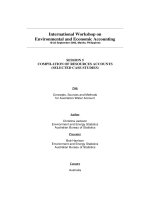Climate change as environmental and economic hazard - phần 1.3
Bạn đang xem bản rút gọn của tài liệu. Xem và tải ngay bản đầy đủ của tài liệu tại đây (97.56 KB, 8 trang )
place to avoid moral hazards. In the case of CCA
and DRR insurance, one such mechanism, as
suggested previously, is to make risk reduction a
prerequisite for access to insurance. For resilience
and vulnerability approaches, other mechanisms
might include community empowerment, capa-
city building and awareness building.
After perturbations to a system, some commu-
nities have been forced to change their liveli-
hood strategies, which are usually connected to
an increase in risk. This was evident after the
1994 eruption of Mt Merapi in Central Java,
Indonesia. A number of factors, including demo-
graphics, politics and the global economy, con-
tributed to the village of Turgo shifting from a
system wherein livestock supported subsistence
agriculture to a system where agriculture sup-
ported market-oriented livestock husbandry
(Dove and Hudayana, 2008). While this usually
would increase risk because households
become more dependent on external factors, in
thecaseofthevillageofTurgo,riskwasmiti-
gated because market participation was limited
to the sale of commodities and not the purchase
of the inputs used in their production. As Dove
and Hudayana (2008, p. 742) note, ‘To continue
reliance on local resources for agricultural pro-
duction (viz. land, labor, livestock, vegetation)
represents a significant buffer against market
uncertainty and volatility’. By keeping one foot
in traditional local subsistence living and one
in global markets, the community created a
dual economy that was able to mitigate risks
associated with changing livelihoods after the
eruption of Mt Merapi and subsequent govern-
ment interventions. Thus, this duel economy
increased the resilience of the socio-ecological
system.
Yet, on a larger scale, there is the lack of a link
to policy-relevant work with the inherent com-
plexity of resilience and vulnerability. While
there are relatively straightforward processes of
doing risk planning, this is not the case for resi-
lience planning. Therefore, we propose a
nested approach at multiple scales, integrating
iterative risk management within a resilience
framework.
6. Information transfer and knowledge networks
A need has arisen to effectively utilize policies,
programmes and institutional structures which
are presently available, or which could be trans-
ferred from one sector to another, to strengthen
the ability of societies to link CCA and DRR.
This strongly relies on effective communication
of information to be transferred and knowledge
networks to be formed, both formally and infor-
mally. This can be accomplished through pro-
cesses of social learning. According to Pelling
et al. (2008), social learning has been interpreted
within the literature to mean both individual
learning that is conditioned by its social environ-
ment, and learning in the sense that social collec-
tives such as organizations and institutions can
‘learn’ in their own right. These are distinct but
complementary aspects of learning within organi-
zations. The authors discern that since collabora-
tive learning among peers facilitates learning,
there is a possibility that informal ‘communities
of practice’ can allow for knowledge to be diffused
more efficiently and be more open (or in some
cases, more constrained), thus impacting on the
collective adaptive capacity of institutions, organ-
izations and communities (Pelling et al., 2008).
An important component of social learning
is facilitating useful knowledge networks and,
moreover, identifying existing networks in order
to support them through capacity building.
Experience has shown that by making existing
local networks more robust, a community,
instead of outside ‘experts’, can sustain a project
or programme more easily than a new network
created by outside knowledge and expertise.
Many communities have both formal institutions
and networks such as government bodies, com-
munity organizations and customary laws, as
well as informal networks that prove to be very
effective during a disaster.
Special attention should also be given to
the ‘shadow systems’ within organizations and
communities, which allow individuals to affect
organizational dynamics in an informal manner.
Shadow systems, also referred to as ‘informal
institutions’, are informal systems that are not
180 Collier et al.
ENVIRONMENTAL HAZARDS
regulated, do not represent formal roles, but often
are dominant drivers of systems. These informal
networks may imply that an organization could
almost dissolve and still retain the original func-
tion of the organization. By enhancing the under-
standing of how these shadow systems and other
institutional factors promote resilience, insti-
tutions and organizations could be reorganized
and/or adjusted to accomplish our goals of
strengthening systems resilience. Stacey (1996)
and Shaw (1997) argue shadow systems signifi-
cantly contribute to learning and innovation in
organizations. A challenge is for organizations
to support, without managing, these informal
systems (Stacey, 1996; Shaw, 1997). This can
also apply to shadow systems outside institutions
and organizations, such as the shadow systems in
local communities.
Few researchers have investigated the relation-
ships between learning, communication and
adaptive capacity. Yet, those that have argue that:
Relational attributes of organizations and
policy regimes allow individuals or sub-groups
within organizations to experiment, imitate,
communicate, learn and reflect on their
actions in ways that can surpass formal pro-
cesses within policy and organizational set-
tings ... offering a potential method for
measuring adaptive capacity that focuses on
process rather than output, enabling proactive
adaptation (Pelling et al., 2008).
Studies further identify components of these con-
cepts as (1) learning by doing, (2) integrating
knowledge systems, (3) increasing collaboration
and equity among community, regional and
national levels, and (4) creating greater flexibility
in management techniques (Olsson et al., 2004;
Armitage et al., 2007). Again we see these propo-
sals as complementary to the influence of social
learning, knowledge networks and iterative risk
management in linking CCA and DRR. Further-
more, we propose institutional changes, namely
the creation of ‘boundary organizations’ as an
important component of such efforts. Likewise,
we suggest the development of innovative and
layered institutions that facilitate learning
through change and complexity (as do Dietz
et al., 2003).
We now return to the earlier question of
‘why are communities still so vulnerable?’ We
propose another possible response, linked to our
previous discussion. The use of iterative risk man-
agement, the efficient transfer of knowledge and
development of knowledge networks described
in the preceding sections, as well as the develop-
ment of boundary organizations and insti-
tutional changes described in the following
sections, all foster growth in underlying determi-
nants of adaptive capacity. These range from gov-
ernance issues, to recognizing and using human
social capital, to understanding causal links and
spreading risk to promote resilience, just to
name a few. If the weakest link hypothesis pro-
posed by Tol and Yohe (2007) holds true, then
all these components are necessary to strengthen
socio-ecological resilience. Up to now, disaster
relief and development interventions have
focused on one episode or one component at a
time, ameliorating effects and events but not
building support to lower vulnerability to future
events. In short, weaknesses elsewhere have pre-
vented increases in resilience because capacities
have not increased.
7. Developing boundary organizations
The world has faced huge disasters over the last
few decades and concerns have been expressed
by nearly all international agencies involved
that there is a scarcity of managerial skills to
deal with the mitigation and management of dis-
asters (Silva, 2001; APA, 2005; IRC, 2005; WHO,
2005; MacFarlane et al., 2006; UN Commissioner
for Refugees, 2006). These skills are needed in
both science and practice. We suggest that
boundary organizations can fulfil this niche and
are essential to achieve many objectives necessary
to link CCA and DRR, such as utilizing iterative
risk management and adaptive co-management,
using a dynamic systems approach to socio-
ecological resilience, and considering multiple
scales when designing CCA and DRR strategies.
Strengthening socio-ecological resilience 181
ENVIRONMENTAL HAZARDS
Yet, to date there is a lack of fluidity between
research, policy and practice.
The term ‘boundary organization’ is not a new
one. It has previously been used in the social
sciences and environmental sciences, most
often referred to as ‘intermediate organizations’
(Guston, 1995; 2001; Cash et al., 2002; 2006;
Hellstrom and Jacob, 2003; Brooke, 2008). The
Harvard University Global Environmental Assess-
ment (GEA) Project defines such organizations as
‘institutions that straddle the shifting divide
between politics and science ...It is hypothesized
that the presence of boundary organizations
facilitates the transfer of usable knowledge
between science and policy’ (Guston, 2001).
Several examples of such institutions include
the Sea Grant Program in the US, the Subsidiary
Body for Scientific and Technological Advice
(SBSTA) of the UNFCCC, the Stockholm Environ-
ment Institute, and ProVention Consortium of
the World Bank.
Pointing out that science was traditionally kept
separate to protect its legitimacy, Jasanoff’s (1990)
work on the advisory relationship between scien-
tists and regulatory agencies demonstrated that
blurring the boundaries between science and
politics could lead to more productive policy
making than could be achieved by maintaining
intentional separation. While boundary organi-
zations have not been extensively researched for
CCA or DRR, there are some emerging exceptions.
Brooke (2008) argues that ‘boundary organi-
zations – organizations or institutions that
bridge different scales or mediate the relationship
between science and policy – could prove useful
for managing the transdisciplinary nature of
adaptation to climate change, providing com-
munication and brokerage services and helping
to build adaptive capacity’ in regards to biodiver-
sity conservation and CCA. Another notable
exception is Ludwig et al. (2009), who assert
that ‘climate-proofing requires, like other
environmental problems, clearly (re)defined and
negotiated boundaries between science and
policy ...problem-defining, policies and research
agendas need to be mutually constructed in
boundary organizations, which may also lie
outside the traditional domain of water resources
management’ (Ludwig et al., 2009, p. 119). While
related to CCA and DRR, these views of boundary
organizations still seem to focus on science and
policy, not science and practice. Thus, we argue,
while human capital is improving, ‘applicable’
human capital lags behind.
The small difference between these previous
definitions of boundary organizations and our
current proposal is that Guston (2001) focuses
on how science can guide policy making while
not becoming politicized and Brooke (2008)
focuses on biodiversity conservation and CCA
and argues that non-governmental organizations
are the appropriate actors to fill this niche because
they tend to be active across the areas of science,
policy and practice. Here, we propose the use of
boundary organizations specifically to link CCA
and DRR while arguing that a variety of existing
institutions could be reorganized to fill this
niche. We see boundary organizations as necess-
ary to catalyse fluid communication and infor-
mation transfer between science, policy and
practice, not just science and policy. As Vogel
et al. suggest:
... Where the science–practice interaction is
not taken seriously or carefully designed, a
number of disconnections can emerge that
frustrate otherwise well-meaning measures to
reduce vulnerability and enhance resilience
... thus, although there is a growing body of
knowledge on vulnerability, adaptation, and
resilience, and a variety of pressing application
opportunities for that knowledge, all too often
still silos of knowledge get produced that fail to
help make systems and communities more
robust to extremes and to change (Vogel
et al., 2007, p. 352).
Additionally, it seems that most of the existing
work on boundary organizations focuses on sys-
tematically incorporating scientific advice into
the decision making of Western, democratized
governing bodies and organizations. Further-
more, this body of work has focused heavily on
formal institutions with multiple stakeholders
in the Global North. Thus, emphasis has not
182 Collier et al.
ENVIRONMENTAL HAZARDS
been placed on the complex knowledge networks
and informal institutions of communities in
developing countries. We, therefore, see a need
to extend these ideas to those institutions, com-
munities and socio-ecological systems in the
Global South.
8. Conclusions
Even though substantial discussion is taking place
at the academic and policy levels in terms of incor-
poration and interaction of various concepts like
CCA, DRR and socio-ecological resilience, very
little has actually happened on the ground. We
propose an urgent need for a dynamic systems
approach to socio-ecological resilience as a
primary objective for CCA and DRR. We further-
more suggest an immediate need for scholarly
research to address the needs and concerns of prac-
titioners on the ground. We have discussed two
primary mechanisms to catalyse change in the
fields of CCA and DRR. These include an increased
use of iterative risk management for adaptive
decision making and the establishment of bound-
ary organizations and institutional changes that
increase the transfer of knowledge between
science, policy and practice.
As the boundaries between disciplines are
linked, the traditional methods of quality
control and scientific reward systems appear
increasingly outdated. The conventional scienti-
fic institutional structures might require signifi-
cant adjustment as researchers and practitioners
attempt to cross disciplinary boundaries and the
boundaries between science and practice. A
dynamic systems approach to socio-ecological
resilience may provide a significant opportunity
to restructure institutions to fulfil this role.
Embedding boundary organizations into aca-
demic institutions might be one way to deal
with the institutional obstacle.
The Forum held on 23– 24 April 2009 at the
Yale School of Forestry and Environmental
Studies, entitled ‘A Dynamic Systems Approach
to Socio-ecological Resilience and Disaster Risk
Reduction: Prioritizing the Gaps in a Changing
World’, identified innovative and interdisciplin-
ary scientific work as a key contributor to past
and future resilience work. All participants in
the Forum agreed that academic institutions
and young scholars, respectively, provide signifi-
cant opportunity to develop boundary organiz-
ations, as well as individuals who can work
between disciplines and substantially increase
communication between science, policy and
practice.
Promoting a dynamic systems approach to
socio-ecological resilience might provide the
perfect opportunity to restructure the scientific
institution, pave the way for a new generation
of scholars, and increase collaboration between
the young and the seasoned within academic
institutions, development and relief organiz-
ations and government. We see this path,
embedded in adaptive and iterative risk manage-
ment, as the way forward for CCA and DRR.
Acknowledgements
Our deepest gratitude to all the participants of
the Forum on socio-ecological resilience that
informed this review article: W. Neil Adger,
J. Marty Anderies, Margaret Arnold, Robert
Bailis, Benjamin Cashore, Dhar Chakrabarti,
Michael R. Dove, Janot-Reine Mendler de
Sua
´
rez, Jacobo Ochara
´
n, Chadwick Oliver,
Elinor Ostrom, Mark Pelling, Reinhard Mechler,
Pablo Sua
´
rez and Robert Watt. We also thank
Boris Porfiriev for insightful comments during
the review process. We would like to recognize
the Yale School of Forestry and Environmental
Studies, in particular James Gus Speth, Gordon
Geballe and the dedicated graduate students,
who all helped to make this endeavour a
success. And finally, the Forum was made possible
by the generous support of the Yale School of For-
estry and Environmental Studies Student Affairs
Committee, The Leitner Family Fund, the Yale
Council on Latin American and Iberian Studies,
the Yale Council on South Asian Studies, the
Global Institute on Sustainable Forestry, Yale
Forest Forum and the World Wildlife Fund. The
Strengthening socio-ecological resilience 183
ENVIRONMENTAL HAZARDS
views expressed in this article are solely those of
the authors and do not reflect any views of the
institutions and organizations mentioned above.
References
Adger, N. W., Huq, S., Brown, K., Conway, D. and
Hulme, M., 2003. Adapting to climate change in
the developing world. Progress in Development
Studies, 3(3). 179–195.
Allen, K. M., 2006. Community-based disaster prepa-
redness and climate adaptation: local capacity-
building in the Philippines. Disasters, 30(1).
81–101.
Anderson, M. B. and Woodrow, P. J., 1998. Rising from
the Ashes. Lynne Reiner Publishers, Boulder, CO.
APA (American Planning Association) New Orleans Plan-
ning Assessment Team, 2005. Charting the Course for
Rebuilding a Great American City – an Assessment
of the Planning Function in Post-Katrina New Orleans.
American Planning Association. www.planning.org/
katrina/pdf/rebuildingreport.pdf.
Armitage, D., Berkes, F. and Doubleday, N., 2007. Adap-
tive Co-Management: Collaboration, Learning, and
Multi-Level Governance. University of British Colum-
bia Press, Vancouver, BC.
Ban Ki-moon, 2008. www.unisdr.org/eng/media-room/
media-room.htm.
Blaikie, P., Cannon, T., Davies, I. and Wisner, B., 1994.
At Risk: Natural Hazards, People’s Vulnerability, and
Disasters (1st edn). Routledge, London.
Brooke, C., 2008. Conservation and adaptation to
climate change. Conservation Biology, 22(6).
1471–1476.
Capra, F., 1996. The Web of Life: A New Scientific Under-
standing of Living Systems. Doubleday, New York, NY.
Carpenter, S., Walker, B., Anderies, J. M. and Abel, N.,
2001. From metaphor to measurement: resilience
of what to what? Ecosystems, 4(8). 765– 781.
Carr, L. J., 1932. Disaster and the sequence-pattern
concept of social change. American Journal of
Sociology, 38(2). 207–218.
Cash, D. W., Clark, W. C., Alcock, F., Dickson, N.,
Eckley, N., Guston, D. H., Ja
¨
ger, J. and Mitchell,
R. B., 2002. Knowledge systems for sustainable devel-
opment. Proceedings of the National Academy of
Sciences USA, 100. 8086–8091.
Cash, D. W., Adger, W. N., Berkes, F., Garden, P., Lebel,
L., Olsson, P., Pritchard, L. and Young, O., 2006.
Scale and cross-scale dynamics: governance and
information in a multilevel world. Ecology and
Society, 11(2). 8.
Coleman, F. C. and Williams, S. L., 2002. Overexploit-
ing marine ecosystem engineers: potential conse-
quences for biodiversity. Trends in Ecology and
Evolution, 17(1). 40–44.
Common, M., 1995. Economists don’t read Science.
Ecological Economics, 15(2). 101–103.
Dietz, T., Ostrom, E. and Stern, P., 2003. The struggle
to govern the commons. Science, 302(5652).
1907–1912.
Dobson, A. P., Bradshaw, A. D. and Baker, A. J. M.,
1997. Hopes for the future: restoration ecology
and conservation biology. Science, 277(5325).
515–522.
Dove, M. R. and Hudayana, B., 2008. The view from the
volcano: an appreciation of the work of Piers Blaikie.
Geoforum, 39. 736–746.
Dovers, S. R. and Handmer, J. W., 1992. Uncertainty,
sustainability, and change. Global Environmental
Change, 2(4). 262–276.
Folke, C., 2006. Resilience: the emergence of a perspec-
tive for socio-ecological systems analyses. Global
Environmental Change, 16(3). 253–267.
Gallopı
´
n, G. C., 2006. Linkages between vulnerability,
resilience, and adaptive capacity. Global Environ-
mental Change, 16(3). 293–303.
Guston, D. H., 1995. Five tensions between science and
democracy. Forum
Proceedings:
Vannevar Bush II
Science for the 21st Century. 239–242.
Guston, D. H., 2001. Boundary organizations in
environmental policy and science: an introduction.
Science, Technology, and Human Values, 26. 87–112.
Handmer, J. W., 2003. We are all vulnerable. Australian
Journal of Emergency Management, 18. 55 –59.
Hellstrom, T. and Jacob, M., 2003. Boundary organi-
zations in science: from discourse to construction.
Science and Public Policy, 30(4). 235.
Helmer, M. and Hilhorst, D. J. M., 2006. Natural disas-
ters and climate change. Disasters, 30(1). 1–4.
Hogarth, R. M. and Kunreuther, H. C., 1985. Ambiguity
and insurance decisions. American Economic Review,
75(2). 386–390.
Holling, C. S., 1973. Resilience and stability of ecologi-
cal systems. Annual Review of Ecology and Systematics,
4. 1–23.
Huq, S. and Klein, R. J. T., 2003. Adaptation to Climate
Change: Why and How. SciDev.Net Climate Change
Dossier, Policy brief. www.scidev.net/dossiers/index.
cfm?fuseaction¼printarticle&dossier¼4&policy¼44.
IFRC (International Federation of the Red Cross and
Red Crescent Societies), 2003. World Disasters
Report 2003. Oxford University Press, Oxford.
184 Collier et al.
ENVIRONMENTAL HAZARDS



